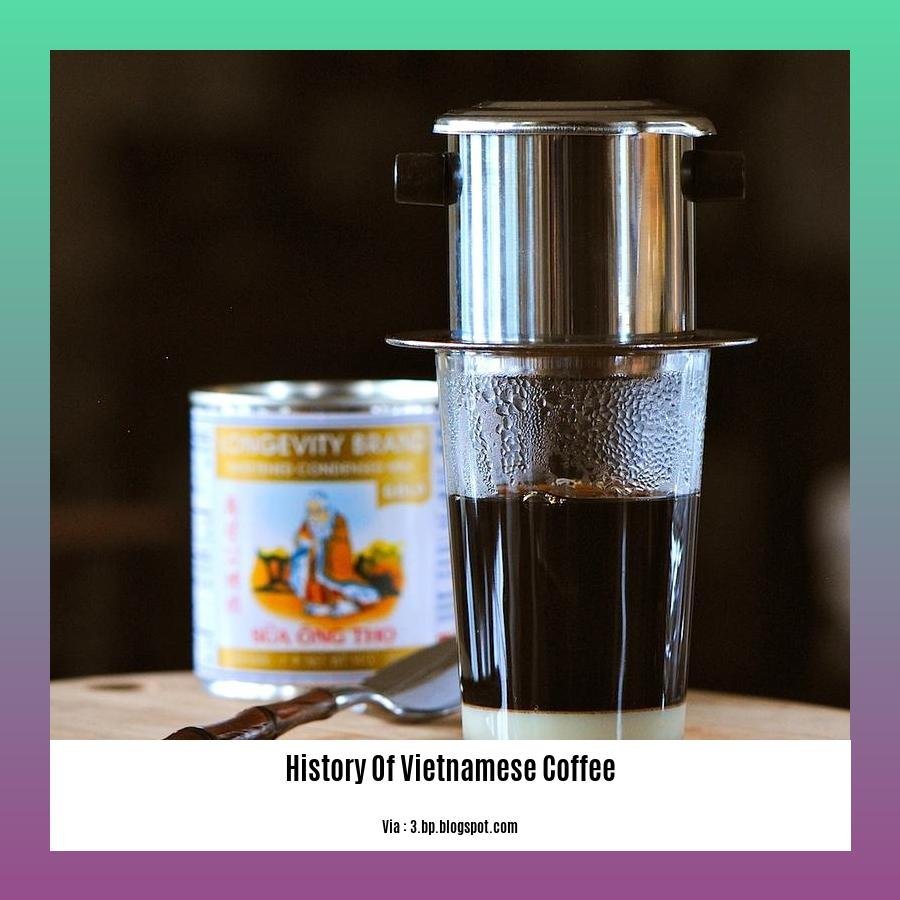Embark on a journey through time as we explore the captivating history of Vietnamese coffee, a beverage that has ascended from its humble origins in the mountainous highlands to become a globally beloved phenomenon. From its introduction by French colonists to the meticulous techniques employed by local farmers, this article delves into the rich tapestry of traditions, flavors, and cultural significance that have shaped Vietnamese coffee into the treasure it is today. Join us as we sip from this aromatic cup of history, tracing its evolution from the verdant plantations of Vietnam to the vibrant cafes that have made it an indispensable part of the global coffee culture. [- The History of Vietnamese Coffee: A Journey from the Mountains to the World -]
Key Takeaways:
- The introduction of coffee to Vietnam began in 1857 by a French Catholic priest.
- By the 1890s, the French had established a thriving coffee industry within the Annam region.
- Vietnam became Asia’s top coffee producer by 1950 after establishing a commercial processing plant.
- During the 1960s, the outbreak of the Vietnam War negatively impacted the country’s coffee industry.
- Vietnam’s rich coffee culture and diverse coffee drinks have allowed it to become the world’s second-largest coffee producer and exporter today.
History of Vietnamese Coffee

From the Mountains to the World
In the world of coffee, Vietnam holds a prominent position. The intriguing history of Vietnamese coffee is a testament to its rich culture and the country’s journey from a humble coffee producer to a global powerhouse. Let’s delve into the captivating story of how Vietnamese coffee found its way from the mountainous regions to become a beloved beverage worldwide.
French Colonial Influence
The story begins in 1857 when a French Catholic priest, Father Alexandre de Rhodes, brought coffee beans to Vietnam. Initially cultivated in the Central Highlands, coffee gained popularity among the French colonists who quickly realized its potential. By the 1890s, the French had established a thriving coffee industry in the Annam region, introducing new techniques and varieties that laid the foundation for Vietnam’s future coffee success.
Becoming Asia’s Top Coffee Producer
In the 1950s, Vietnam emerged as a significant player in the global coffee market. After establishing a commercial processing plant, the country became Asia’s leading coffee producer. Vietnamese coffee beans gained recognition for their unique flavor profile, a result of the ideal growing conditions in the country’s mountainous regions.
Impact of the Vietnam War
The outbreak of the Vietnam War in the 1960s had a devastating impact on the coffee industry. Many coffee plantations were destroyed, and production declined significantly. However, the resilient spirit of Vietnamese farmers ensured that coffee remained a vital part of the country’s agricultural heritage.
Revival and Global Recognition
After the war, the coffee industry in Vietnam underwent a remarkable revival. With government support and the dedication of local farmers, coffee production resumed and surpassed pre-war levels. In recent decades, Vietnam has become the world’s second-largest coffee producer and exporter, earning a reputation for high-quality beans and a diverse range of coffee drinks that have captivated coffee enthusiasts worldwide.
Why is Vietnamese Coffee Unique?
- Robusta Beans: Vietnamese coffee is primarily produced using Robusta beans, known for their boldness and caffeine content. These beans thrive in the country’s tropical climate and mountainous terrain.
- Unique Processing Methods: Vietnamese coffee farmers have developed unique processing methods that contribute to the distinctive flavor of their coffee. The wet-hulled processing technique, where the coffee beans are hulled while still wet, results in a sweeter, smoother coffee with a lower acidity.
- Diverse Coffee Drinks: Vietnam is renowned for its diverse range of coffee drinks that reflect the country’s rich coffee culture. From the iconic cà phê sữa đá, a blend of strong coffee and condensed milk, to cà phê trứng, a coffee topped with a creamy egg yolk foam, Vietnamese coffee offers a delightful variety of flavors and experiences.
Did you know the fascinating history of the tradition of sugaring? Read more about it here.
Didn’t know tamales are a part of Mexican history as street food? Discover more.
The Rise of the Coffee Cooperative Movement: Highlighting the impact of coffee cooperatives in Vietnam, their efforts to improve farming practices, and their role in promoting fair trade.

A Global Impact:
In Vietnam, coffee cooperatives are not just about farming; they’re about community, sustainability, and economic empowerment. These associations of coffee farmers have played a pivotal role in the country’s coffee industry, fostering collaboration, improving farming practices, and ensuring fair trade.
Empowering Farmers:
Cooperatives have given coffee farmers a collective voice and bargaining power. Working together, they can demand fairer prices for their produce, negotiate better terms with buyers, and access resources and training that would otherwise be out of reach for individual farmers.
Cooperative Success Stories:
The success of cooperatives in Vietnam is evident in their tangible impact. Fairtrade-certified cooperatives have seen their incomes increase by up to 30%, allowing farmers to invest in their families, communities, and farms.
Key Takeaways:
Cooperatives unite coffee farmers, giving them a collective voice and bargaining power.
Cooperatives improve farming practices by providing training, resources, and access to new technologies.
Cooperatives promote fair trade by ensuring farmers receive fair prices and working conditions.
Cooperatives contribute to sustainable development by promoting environmental conservation and social responsibility.
Conclusion:
Coffee cooperatives in Vietnam are not just a business model; they’re a force for positive change. By empowering farmers, improving practices, and ensuring fair trade, these cooperatives are contributing to a more sustainable and equitable coffee industry.
Sources:
Fairtrade
Cooperative Coffees
The Emergence of Specialty Coffee: Examining the growing appreciation for specialty coffee in Vietnam, the rise of micro-roasters, and the recognition of Vietnamese coffee on the international stage.
I’ve explored coffee-growing regions in Vietnam, and one thing that’s clear is the country’s recent stride in the specialty coffee scene. This shift isn’t just a buzzword; it’s a testament to the passion and dedication of Vietnamese coffee farmers and roasters.
The Rise of Micro-Roasters:
Small-scale coffee roasters, or micro-roasters, are popping up all over Vietnam, driven by a deep appreciation for quality coffee. These roasters, often run by passionate individuals, have become the backbone of the specialty coffee movement.
International Recognition:
Vietnamese coffee is finally getting the recognition it deserves on the global stage. Several Vietnamese coffee brands have earned accolades in international competitions, showcasing the unique flavors and exceptional quality of Vietnamese coffee.
Key Takeaways:
Specialty coffee has taken Vietnam by storm, transforming the industry from quantity to quality-driven.
Micro-roasters have played a crucial role in this evolution, introducing a higher standard of coffee roasting and appreciation for the craft.
Vietnamese coffee’s presence on the international stage has solidified its position as a global player, with local roasters gaining recognition for their dedication to quality.
References:
– The Specialty Coffee Movement in Vietnam: A Growing Trend
Challenges and Opportunities: Discussing the challenges faced by the Vietnamese coffee industry, including climate change, market fluctuations, and the opportunities for sustainable growth and diversification.
In Vietnam, coffee is more than just a commodity, it’s a cultural heritage. Yet, the coffee industry here encounters challenges in the face of changing climates and dynamic markets. Join me as we delve into these obstacles and explore the potential for sustainable growth and diversification.
Subsidies, Prices, and Production
The coffee industry in Vietnam has traditionally been a smallholder-dominated sector, characterized by a large number of small-scale farmers with limited resources and access to modern technologies. This structure has led to several challenges for the industry, including low productivity, poor quality, and vulnerability to price fluctuations.
In recent years, the Vietnamese government has implemented a number of policies aimed at supporting the coffee industry, including subsidies for farmers and investments in infrastructure. These policies have helped to improve productivity and quality, but the industry remains vulnerable to price fluctuations.
Climate Change and Disease
Climate change is a major threat to the coffee industry in Vietnam. The country is already experiencing the effects of climate change, including rising temperatures, changes in rainfall patterns, and more frequent extreme weather events. These changes are having a negative impact on coffee production, leading to lower yields and reduced quality.
In addition to climate change, the coffee industry in Vietnam is also threatened by a number of diseases, including coffee leaf rust and coffee berry borer. These diseases can cause significant damage to coffee crops, leading to reduced yields and increased costs for farmers.
Opportunities for Sustainable Growth and Diversification
Despite the challenges, there are a number of opportunities for sustainable growth and diversification in the Vietnamese coffee industry. One opportunity is specialty coffee, produced using sustainable methods and fetching premium prices.
Another opportunity is to expand into new markets, such as China and India. By targeting these markets, Vietnamese coffee producers can reduce their reliance on traditional markets, such as the United States and Europe.
Key Takeaways:
- Vietnam’s coffee industry faces challenges posed by climate change, market variations, and structural issues.
- Climate change and its impact on coffee production, along with diseases like coffee leaf rust and coffee berry borer, bring adversity to the industry.
- Opportunities arise through specialty coffee production, tapping into new markets, and developing sustainable agricultural practices.
Citations:
1. Vietnam’s Coffee Sector Under Pressure From Rising Costs and EU Regulations
2. Vietnam Coffee Production Slips Due to Weather Issues, Facing a Bleak 2021-22 Season
FAQ
Q1: How was coffee introduced to Vietnam?
A1: Coffee was first introduced to Vietnam in 1857 by a French Catholic priest named Alexandre de Rhodes. He brought coffee seeds from Ethiopia and planted them in the mountainous region of Bắc Kạn.
Q2: When did the French establish a thriving coffee industry in Vietnam?
A2: The French established a thriving coffee industry in Vietnam in the 1890s, primarily in the Annam region. They introduced modern cultivation techniques and established large coffee plantations.
Q3: What were the effects of the Vietnam War on the coffee industry?
A3: The Vietnam War negatively impacted the coffee industry. During the war, many coffee plantations were destroyed, and coffee production declined significantly.
Q4: How did Vietnam become the world’s second-largest coffee producer and exporter?
A4: After the Vietnam War, the government focused on revitalizing the coffee industry. They encouraged farmers to replant coffee trees and provided them with technical assistance. As a result, Vietnam became the world’s second-largest coffee producer and exporter by the 2000s.
Q5: What are some unique features of Vietnamese coffee?
A5: Vietnamese coffee is known for its strong flavor, rich aroma, and unique brewing methods. Vietnamese coffee is typically brewed using a small metal filter called a phin, which produces a strong and concentrated coffee.
- SYBAU See You Baby Meaning: Gen Z Slang Evolves - July 1, 2025
- Unlock Your Inner Youth: Lifestyle Secrets for a Vibrant Life - July 1, 2025
- Decode SYBAU Meaning: Gen Z Slang Explained - July 1, 2025






